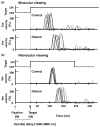Effects of anisometropic amblyopia on visuomotor behavior, I: saccadic eye movements
- PMID: 20671288
- PMCID: PMC5142839
- DOI: 10.1167/iovs.10-5882
Effects of anisometropic amblyopia on visuomotor behavior, I: saccadic eye movements
Abstract
Purpose: Impairment of spatiotemporal visual processing is the hallmark of amblyopia, but its effects on eye movements during visuomotor tasks have rarely been studied. Here the authors investigate how visual deficits in anisometropic amblyopia affect saccadic eye movements.
Methods: Thirteen patients with anisometropic amblyopia and 13 control subjects participated. Participants executed saccades and manual reaching movements to a target presented randomly 5° or 10° to the left or right of fixation in three viewing conditions: binocular, amblyopic, and fellow eye viewing. Latency, amplitude, and peak velocity of primary and corrective saccades were measured.
Results: Initiation of primary saccades was delayed and more variable when patients viewed monocularly with their amblyopic eye. During binocular viewing, saccadic latency exhibited increased variability and no binocular advantage in patients (i.e., mean latency was similar to that during fellow eye viewing). Mean amplitude and peak velocity of primary saccades were comparable between patients and control subjects; however, patients exhibited greater variability in saccade amplitude. The frequency of corrective saccades was greater when patients viewed with their fellow eye than it was with binocular or amblyopic eye viewing. Latency, amplitude, and peak velocity of corrective saccades in patients were normal in all viewing conditions.
Conclusions: Saccades had longer latency and decreased precision in amblyopia. Once saccades were initiated, however, the dynamics of saccades were not altered. These findings suggest that amblyopia is associated with slower visual processing in the afferent (sensory) pathway rather than a deficit in the efferent (motor) pathway of the saccadic system.
Figures




References
-
- American Academy of Ophthalmology. [Accessed September 6, 2010];Amblyopia: Preferred Practice Pattern. 2007 http://one.aao.org/CE/PracticeGuidelines/PPP_http://one.aao.org/CE/Pract....
-
- Membreno JH, Brown MM, Brown GC, Sharma S, Beauchamp GR. A cost-utility analysis of therapy for amblyopia. Ophthalmology. 2002;109:2265–2271. - PubMed
-
- Hensch TK. Critical period plasticity in local cortical circuits. Nat Rev Neurosci. 2005;6:877–888. - PubMed
-
- McKee SP, Levi DM, Movshon JA. The pattern of visual deficits in amblyopia. J Vis. 2003;3:380–405. - PubMed
-
- Hess RF, Wang YZ, Demanins R, Wilkinson F, Wilson HR. A deficit in strabismic amblyopia for global shape detection. Vision Res. 1999;39:901–914. - PubMed
Publication types
MeSH terms
Grants and funding
LinkOut - more resources
Full Text Sources
Medical

